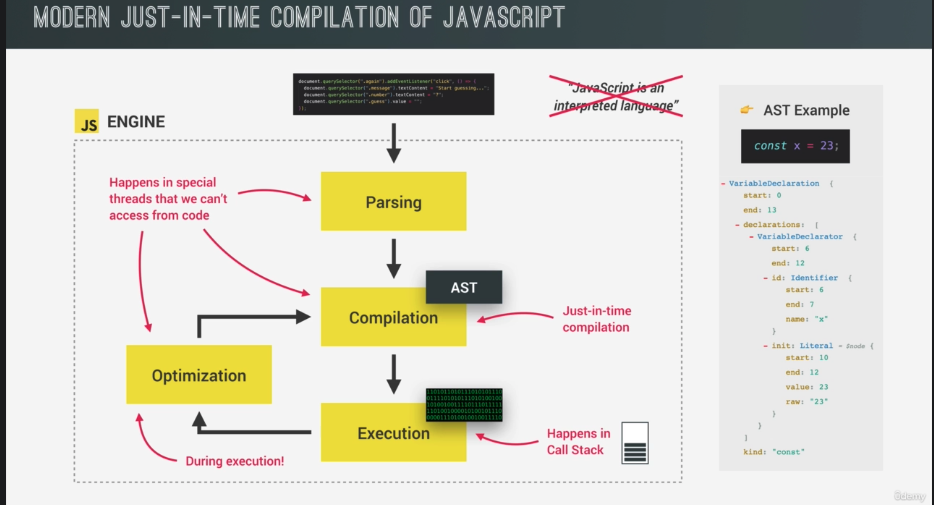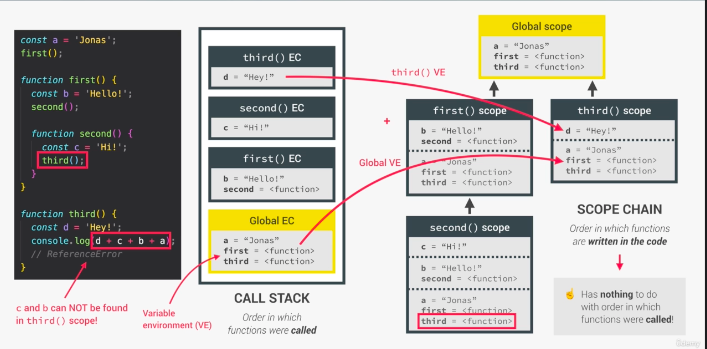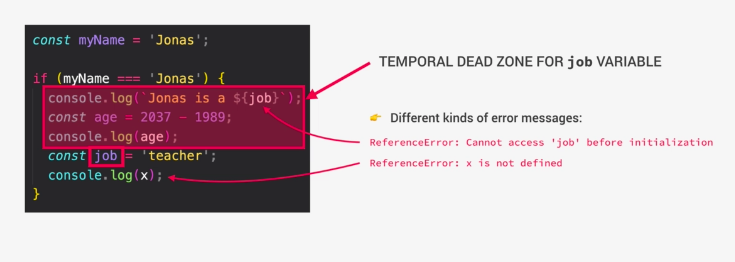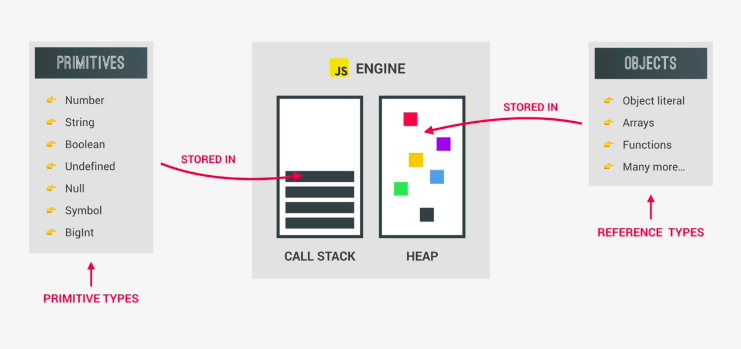JavaScript 的特性
high level 高階(語言)
- 高階指的是接近人類讀得懂的語言,低階則是接近機器的 2 進位的機器碼(machine code)
- 例如 c 語言(低階語言),需要處理宣告新變數時的記憶體
- 而高階語言的 python 跟 JavaScript 不需要,但效能不會有 c 語言好
prototype based object-oriented 物件導向
- JavaScript 資料除了 primitives 都是物件
- 陣列也是物件,只是 key 為 index
|
|
interpreted or just-in-time compiled
- JavaScript 引擎會幫我們轉成 2 進位的機器碼
dynamic-typed 動態資料型態
- 宣告變數時不需要給予型別(C、Java、Ruby 要)
- 容易改變型別
single-threaded 單執行緒
- 一次只能執行一個任務
garbage collected 有記憶體回收機制
- 有機制會自動移除記憶體中老舊或沒有使用的變數
multi-paradigm 可以同時使用多種風格來寫程式
- 可以用 Procedural Programming 程序化程式設計
- 可以用 Function Programming 函式程式設計
- 可以用 Object-Oriented Programming 物件導向程式設計
with first-class functions 一級函式
- 一級函式是一種特性,部分程式語言沒有,而 JavaScript 有
- 一級函式表示在這個語言函式可以被當作一個變數(variable),賦值給其他變數或做為參數傳遞(functions are values)
non-blocking event loop concurrent model
- 由於單執行緒但又得處理同時發生的多種任務,容易阻塞
- JavaScript 引擎會使用 event loop,一個背景執行的 task,任務執行完的結果會放到 call stack
JavaScript 引擎 v.s. 執行環境 runtime v.s. 執行文本 context
JavaScript 引擎
- 各家瀏覽器有自己的 JavaScript 引擎,用來執行 JavaScript
- Google 開發的 V8 引擎,不只用於 Chrome 還有 Node.js(可以在瀏覽器外執行 JavaScript)
- JavaScript 引擎包含一個 Call Stack(execution context)跟一個 Heap
- Heap 是非結構化的記憶體池,儲存所有物件
- interpretation:程式碼轉成一行行執行的 code,再轉成機器碼
- compilation:整包程式碼轉成 machine code(2 進位),再執行程式
- just-in-time compilation: 程式碼轉成 2 進位後立即執行(避免等待)
- 當一段程式碼進到引擎會執行下方程序

|
|
JavaScript Runtime 執行環境
- browser: JavaScript 引擎 + webAPIs + callback queue
- call stack : 由上到下執行 stack 裡面每一行程式,變數的記憶體也是在這個階段建立(hoisting),遇到需要呼叫 API 的非同步函式會把裡面的 call back function 丟到 webAPI 排程執行
- webAPIs 處理非同步函式,當有收到回傳結果,會依照回傳時間順序把 callback function 傳到 callback queue
- 當 stack 清空時,callback queue 就會把 callback function 依序(queue 先進先出)丟到 stack 裡執行
- 這整個過程就是 event loop,為了提高瀏覽器的使用體驗,不會被非同步函式等待過程阻塞的機制

- node.js: JavaScript 引擎 + C ++ bindings & thread pool + callback queue (這邊知道的大概即可)

*stack 是先進後出(後進先出)的資料結構,queue 是先進先出的資料結構
Execution context 執行文本
*為了跟執行環境 runtime 做名詞區隔,使用不同中文名稱指稱
-
執行文本包含
- 變數環境 variable environment: 包含 let const var 宣告, 函式, 參數 arguments obj
- 作用域鏈 scope chain: 讓個別函式可以 ref 到函式外的變數,會存在個別執行文本
- this: 每個執行文本都有自己的 this,在創造階段時誕生(執行階段前)
-
有創造階段跟執行階段
-
箭頭函式沒有自己的 this 或參數,但可以使用父層的 this 或參數
-
執行順序
- step1. 創造全域執行文本(top-level/not inside the function)
只有非 function 的會被執行,因為 function 要被呼叫才會執行
只會有一個 global execution context - step2. 執行全域執行文本(inside global EC)
- step3. 執行函式等待 callback 回傳結果
依序呼叫個別函式,個別函式的文本會被創造
call stack 的內容就是由這些個別函式跟文本所組成
- step1. 創造全域執行文本(top-level/not inside the function)

scope 作用域 & scope chain 作用域鏈
global scope 全域
- 位於 function 跟 block 外
- 可以被所有地方存取
function scope 函式作用域
- 也被稱作 local scope
- 只能在函式內存取,嘗試存取會出現 error
- ES6 開始嚴格模式下也是 block scope
block scope(ES6 開始出現) 區塊作用域
- let 跟 const 被限制只能在 block 範圍內存取
- var 還是可以被 function scope 存取
- ES6 開始嚴格模式下 function scope 也是 block scope(寫兩次因為很重要)
scope chain
- 當變數不存在現有 scope,無論是 block 或 function 都可以讀外面父層裡的變數
- 找不到時會一層層往外找(variable lookup),完全找不到會出現 ReferenceError
- 只能往外找,不能往內 console.log(function 或 block 裡面的變數)會 ReferenceError
- sibling 之間不行互相讀取
- 每個 scope chain 都包含他的變數跟的父層的變數
- scope chain 可以讀取的變數跟 function 在 call stack 執行順序無關

callstack v.s. scope chain
- 使用下方函式舉例
- step1. 創造全域執行文本
- 全域變數環境:a=‘Jonas’, first=fn, third=fn
- step2. 執行全域執行文本,創造出個別執行文本
first()作用域:可以獲取本地作用域跟父層的變數環境
- 變數環境:b=‘Hello’, second=fn, a=‘Jonas’, first=fn, third=fn second()作用域:可以獲取本地作用域跟父層的變數環境
- 變數環境:c, b=‘Hello’, second=fn, a=‘Jonas’, first=fn, third=fn third()作用域:可以獲取本地作用域跟父層的變數環境
- 變數環境:d=‘Hey’, a=‘Jonas’, first=fn, third=fn
- step3. 執行個別文本(執行函式),等待 callback 回傳結果
|
|

*下方是另一個範例,輸出結果用//表示,且視為單獨出現這行的狀況(彼此之間不影響)
|
|
總結
- 要了解變數存活的區域,哪裡可以獲取這些值
- 如何設計變數的位置跟獲取程式的變數
- lexical scoping 是使用 function 跟 block 等封閉環境,控制變數存取
- scope 宣告變數的環境,有 global 全域, function 函式跟 block 區塊三種作用域
- 所有 scope 都可以獲取父層的 scope,因為這是一條 scope chain
Hoisting 提升
- 表面上是可以在宣告前被使用
- 其實是在執行階段前,已經在創造階段就建立在變數環境(variable environment)
- 不同變數行為不同
函式宣告
- 函式宣告會提升
- 未宣告使用為實際值
- 變數存取範圍嚴格模式下為 block scope,非嚴格模式下為 function scope
var
- var 會提升
- 未宣告使用為 undefined
- 變數存取範圍為 function scope
const/let
- const 跟 let,技術上來說有提升但是未初始化 uninitialized 沒有可取用的值
- 未宣告使用下會被鎖在 TDZ(temporary dead zone)
- 變數存取範圍為 block scope

函式表達式跟箭頭函式
- 函式表達式跟箭頭函式若用 var 存取會提升
- 未宣告使用是 undefined,反之則跟 const/let 特性一樣
- 這也是為何在函式表達式中,我們無法使用在宣告變數前調用函式,而函式宣告可以不顧函式宣告順序,任何地方都可以調用
TDZ 是什麼 (ES6 開始出現)
- TDZ 為變數初始化前的區塊
- 下圖 job 在被 const 宣告前被呼叫,會出現 ReferenceError cannot access ‘job’ before initialization,需要宣告後才能被使用
- 但如果呼叫完全沒被創造的變數,會顯示另一種訊息 ReferenceError x is not defined
- 有 TDZ 比較容易抓出未宣告使用的錯誤
- 另一個 TDZ 存在好處是,因 const 無法重新賦值,所以無法設定 undefined 再給新的值,TDZ 可以讓 const 順利運作
- hoisting 的好處:mutual recursion,讓 code 可讀性高,而 var 的 hoisting 算是副產物,後見之明看來不是好東東

*下方輸出結果用//表示,且視為單獨出現這行的狀況(彼此之間不影響)
|
|
- 因為 hoisting 造成的 bug 範例,使用 const/let 可避免,養成先宣告變數再使用的好習慣
|
|
- 當用 var 宣告,會在 browser 的 window(全域變數)下多一個屬性
|
|
this 是什麼?
- 所有執行文本下都會有的特別變數,值取決於被呼叫的方式
- 作為 Method(物件下的 function)呼叫時,this 是呼叫他的變數
- 一般函式呼叫,嚴格模式下 this 值是 undefined,非嚴格模式下為全域物件(瀏覽器為 window/node.js 是 global)
- 箭頭函式沒有自己的 this,this 值取決於父層(parent scope)
- eventListener 呼叫時,指向觸發的元素
- this 不會是函式自己,也不會是變數環境(Variable Environment)
- new, call, apply, bind 會於其他篇介紹
*下方輸出結果用//表示,且視為單獨出現這行的狀況(彼此之間不影響)
|
|
讓 this 指向父層的 2 種做法
|
|
一般函式 v.s. 箭頭函式
物件內的函式
- 當使用一般函式會有自己的 this,可以取得 jonas.firstName
- 當使用箭頭函式會沒有自己的 this,會往父層取變數,bug 通常在這裡發生(可能取得 undefined 或真的有一個變數值)
- 全域避免使用 var
|
|
arguments
- 只存在一般函式,箭頭函式沒有
|
|
- arguments 跟其餘運算子的搭配
|
|
- 當函式很多 argument 不好記順序,可以傳入一個物件作為參數,函式會解構物件並執行函式
- 常用於第三方函式庫
|
|
primitives v.s. objects
- primitives 包含 數字、字串、布林、undefined、null、Symbol、BigInt,其他都是 objects
- primitives 記憶體存在 call stack
- objects 記憶體存在 Heap

primitives
- let age = 30 給一個 call stack 的記憶體地址跟 30 的值(0001)
- let oldAge = age 傳 age 的 call stack 地址(0001)給 oldAge
- primitives 的值是 immutable(不可變更),當我們寫 age = 31 會再給一個新的記憶體的地址跟值給 age(0002),而非修改原本的 30 的那塊記憶體(0001)的內容
objects
- const me = {name: ‘Jonas’},給一個 call stack 記憶體的地址跟 Heap 的地址
- 因為物件檔案可能太大,所以記憶體實際上是存在 Heap
- const friend = me,會傳 me 記憶體的地址給 friend
- friend.name = ‘mirenda’ 物件跟上面的 primitives 不同,會改到 me 的值(D30F),值參照同樣的 Heap 地址,並沒有另外再給一個新的記憶體,可以參考下方圖表的箭頭(只有一個)

常用淺拷貝方法
Object.assign(空物件, 複製對象)
- 只能用在物件
|
|
展開運算子
- 除了物件外也可用於 string、array、array-like、Set、Map 等可迭代物件
|
|
以上為The Complete JavaScript Course - From Zero to Expert的小筆記,附上連結推推這堂課
